This year, grandson Matt will graduate from Case Western Reserve University, planning to go on to graduate school in physics. In 2005, he graduated from Friends School here in Baltimore. Here I’m going to show you how I made his high school graduation gift. For each of my projects, I keep a journal to document the process. So here is that journal. Is there anyone interested in reading this?
March 9, 2005. Although I’d been thinking about making a crazy patchwork quilt for Noah, even tacking 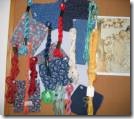 materials I might use to the bulletin board, today I began work on Matt’s graduation gift. After first fooling around with the idea of using a fractal image as the basis for stitchery, I gave that up as too complex and maybe not doable, or at least, not without a lot of experimentation. Then, out of the blue, while meditating yesterday, I got the idea of basing a design on Case Western Reserve University’s logo. I found it at their Website, printed it, traced it, and began thinking of ways to embroider it. This I think
materials I might use to the bulletin board, today I began work on Matt’s graduation gift. After first fooling around with the idea of using a fractal image as the basis for stitchery, I gave that up as too complex and maybe not doable, or at least, not without a lot of experimentation. Then, out of the blue, while meditating yesterday, I got the idea of basing a design on Case Western Reserve University’s logo. I found it at their Website, printed it, traced it, and began thinking of ways to embroider it. This I think  I can do handsomely, using sadi (Do go read about sadi.) and Rajmahal art silk threads, gold and blue, or maybe gold, silver, and blue. On paper, I’ve begun playing with design and stitching ideas, researching filling stitches for more ideas.
I can do handsomely, using sadi (Do go read about sadi.) and Rajmahal art silk threads, gold and blue, or maybe gold, silver, and blue. On paper, I’ve begun playing with design and stitching ideas, researching filling stitches for more ideas.
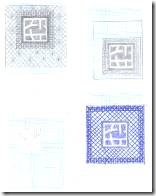
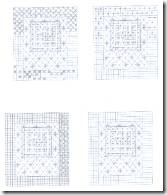
March 11. I’ve framed up a practice cloth of a silky material, ordered silks from Thai Silks, begun to prepare an order for Rajmahal, and I’m still playing with design ideas. Now it’s filling stitches for inside the logo and surrounding it. I think I’ll use a red thread somehow in the logo filling to represent Friends School.
March 21. For the past ten days I’ve been working on the design, making thumbnails of various ways to surround the logo, experimenting with different values, and trying different sizes. Belatedly I thought of using graph paper for creating matrix fillings. And even later I realized that I had the scale wrong in my thumbnails, so I reduced graph paper on the computer to give me the correct scale to practice on.
Yesterday I think I settled on the final design and its size—6.5 x 7.5. 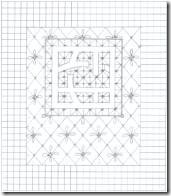 Next comes the stitching plan. I intend to stitch this piece in traditional silk and metal thread embroidery, but there are still many, many decisions to be made about colors (values, since I know it’s going to be blue and gold), weight of threads, types of gold materials, and so on. Lots of experimenting to do on a practice cloth.
Next comes the stitching plan. I intend to stitch this piece in traditional silk and metal thread embroidery, but there are still many, many decisions to be made about colors (values, since I know it’s going to be blue and gold), weight of threads, types of gold materials, and so on. Lots of experimenting to do on a practice cloth.
The last thing I did yesterday was to transfer half of the design to my practice cloth, on which I’d already begun trying out some matrix filling stitches–traditional stitches. The logo will be done in goldwork, but that will require testing and practice to find the technique that works best with this shape.
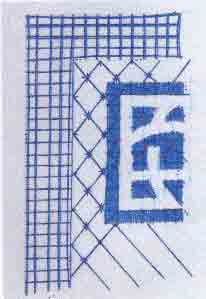
March 27. Now I’m stitching my practice cloth, which I’ve decided to call a study. Using the Rajmahal threads I plan to use in the final piece, I’ve been trying out my ideas for stitching—laid filling for the blue part of the logo, matrix filling for the two borders. Still haven’t decided for sure how to use red, which I want to incorporate to represent Friends School and to give added liveliness to the otherwise monochromatic color scheme. Haven’t made much progress in the past week because of a dentist’s appointment and a trip to the National Gallery of Art.
April 4. This project is going very slowly. Last week I had an ophthalmologist appointment, our mailman’s retirement party, and cooking Indian dishes for our party every day from Wednesday till Saturday. Yesterday I went to Matt’s choir concert. Now I have to settle down to work steadily on this piece.
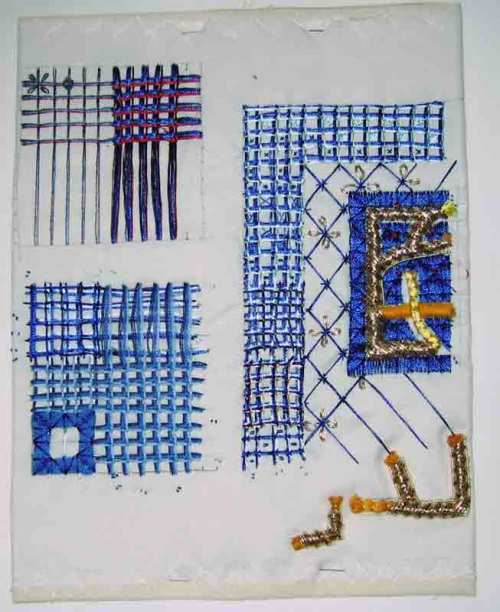
After doing all these studies, I discovered that the reason why I could not get perfect squares with the three threads lined up in battlement couching is because the Rajmahal threads are too slick and slippery. When I experimented with cotton threads, the couching looked just the way I wanted it to—a shadowbox effect.
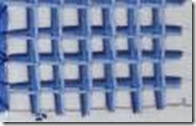
I also thought of a better way of stitching the outside edge of the logo—using six-strand couching. It looks much smoother than the lines of laid threads.
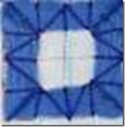
Cutting the sadi pieces all the same length is a challenge. The sadi is not straight, so it’s difficult to judge the length. I have decided on the size of the loops I want to make, though. Now I need to do more studies of filling stitches for the outer border. When I’ve decided on how to do that, I’ll practice the goldwork for the logo.
April 7. Yesterday I stitched more studies for the outer border. I prefer numbers 4 and 5 and couldn’t decide which, if either, of these I’ll use.
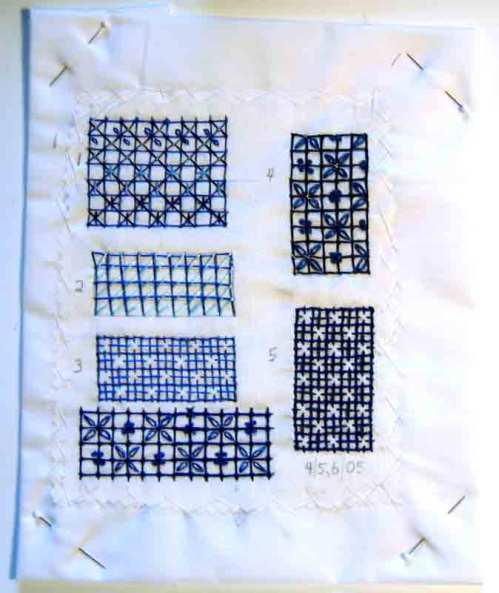
To help me decide, I drew thumbnails to see how my two favorite patterns would look in the whole design.
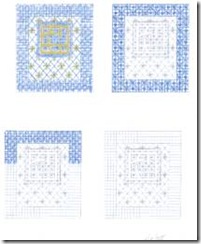
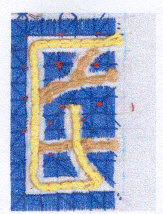
Today I’ve begun padding the logo for goldwork. The purpose of this study is to determine what materials and how much to use for the padding under the goldwork. I’ve couched down four strands of tan craft thread and covered that with 18 strands of gold silk thread. Already I can see that the corners as I’ve stitched the padding are rounded, not as square as I want them to be. I’m going to try covering the remaining tan padding with gold felt, to see what differences there are when I attach the gold over the different paddings.
April 9. Here’s the first study in goldwork. I haven’t yet got the length of the sadi right. I think the line looks too broad. Haven’t yet decided whether to use some silver sadi in this metal work. And I have to work out which way to slant the stitches. It’s starting to look better. I tried pearl sadi as outline and decided that I like all gold better than mixed silver and gold.
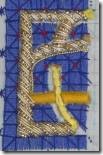
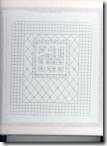
April 11. Today I attached the foundation fabric and the ground fabric to the frame and transferred the design. I’m still not satisfied with the technical aspects of the goldwork, nor am I sure of the pattern for the outer border, but I will work these out, maybe with more studies, as I proceed. I’ve learned to keep going, even when I lack confidence.
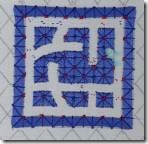 April 14. I’m not satisfied with the red accents and am going to unstitch them.
April 14. I’m not satisfied with the red accents and am going to unstitch them.
 The reason why I was dissatisfied with the red stitches is because I screwed up when I drew the center matrix. I intended to have “a” and instead I drew “b”. Oh well, it won’t spoil the final effect. I used dark blue to create the accents.
The reason why I was dissatisfied with the red stitches is because I screwed up when I drew the center matrix. I intended to have “a” and instead I drew “b”. Oh well, it won’t spoil the final effect. I used dark blue to create the accents.
April 21. The Japanese use temporary holding stitches to keep long laid stitches in place until the permanent matrix stitches are put down. Then the temporary stitches are removed. I didn’t think to do that with the long stitches in the logo. Consequently, they didn’t stay in straight lines as I put the matrix stitches over them. Lesson learned. I’m learning a lot from doing this piece.
I used 18 lengths of DMC dark gold cotton floss for the padding. That was exactly the amount of padding needed. However, the goldwork in the logo does not satisfy me: there are broken and misshapen purls; not all the purls are the same length; in one place the padding was not as heavy (some threads pulled out and I thought it wouldn’t matter) and so the line of goldwork looks a little skimpy; and the corners are not perfect. But it doesn’t look bad enough for me to feel I have to do it over. To the untrained eye, it will look spectacular. Only I will know how much better it could be.
April 24. With the sadi purl and the Rajcord outlines in place, the laid threads look okay. I can detect only two gaps that I may be able to fix or compensate for.
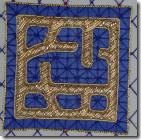
The first sadi loops I made (lower left) are uneven. After doing them, I worked out a technique to cut all the purls the same length and to attach them without inadvertently pulling the thread too tight, thus breaking or distorting the purls. I’m pleased with the last three I did yesterday.

April 29. The grid lines in the outer border have not been stitched down yet, as I’m still deciding whether they should be heavier, have more threads added.
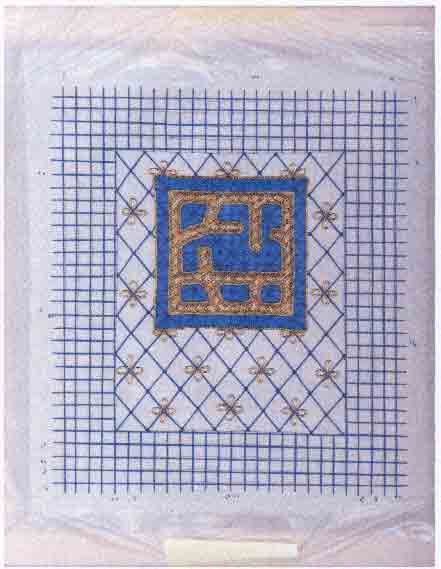
I’m also still experimenting with various ways of adding filling stitches. Here is one study worked on the grid– using three strands of silk for the grid.

I’m having trouble controlling the multiple strands of silk in the lazy daisy stitches and the French knots. In addition to trying different numbers of strands of thread, I’m also going to try using a different needle, a straw or milliner’s needle, which may work better with the French knots.
I had to stitch some of the gold loops in the inner border several times to get them right. Some of them are still a little irregular. I may decide to redo them when I’ve finished the outer border, before framing it. Precision is part of the beauty of this kind of work, not my forte! But an irregular kind of design would not work with the Case logo. Or at least, this is the design I came up with that I liked best. So I have to stitch it appropriately. If I’m unable to master a technique for this filling stitch pattern, I’ll have to go to a different pattern.
May 2. After experimenting with four threads in the milliner’s needle and different stitches, I settled on six strands and drew a grid for practice. I also used the tekobari to separate the strands so they would lay smoothly parallel. What a difference! This study is much prettier than previous ones.

I’ve finally got it—the material, the tools, and the technique—stitching very slowly and shaping the lazy daisies and French knots with the tekobari and my fingers as I slowly pull the thread through. Now I’m back to working on the final piece, adding three strands of thread to the grid lines, which I will stitch down with cross stitches in three strands of 126, to match the lines. The lazy daisies and French knots will be in 122.
May 9. Looks like I’m going to run out of 122, so I’ve ordered more. I had just enough of 126, but ordered more just in case. I’ve almost finished stitching the outer border and have definitely decided to replace some of the gold loops. I’m also going to add a line of six strands of 126 couched between the inner and outer borders. The frame is assembled and looks great against the embroidery.
May 18. While waiting for the threads to arrive, I replaced eight of the gold sadi loops. By the way, the red I wanted to incorporate for Friends School is in the center of those gold loops. Today I finished Matt’s gift. It’s all framed and ready to give. It took 90 hours to complete this project, 16.5 hours of that on design.
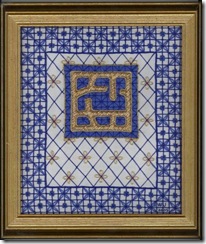
A better shot on Flickr.

Read Full Post »

















 Six weeks ago, Veronique sent me her Helping Hands award, which I am supposed to award to five or ten people who have been helping hands to me.
Six weeks ago, Veronique sent me her Helping Hands award, which I am supposed to award to five or ten people who have been helping hands to me.








































